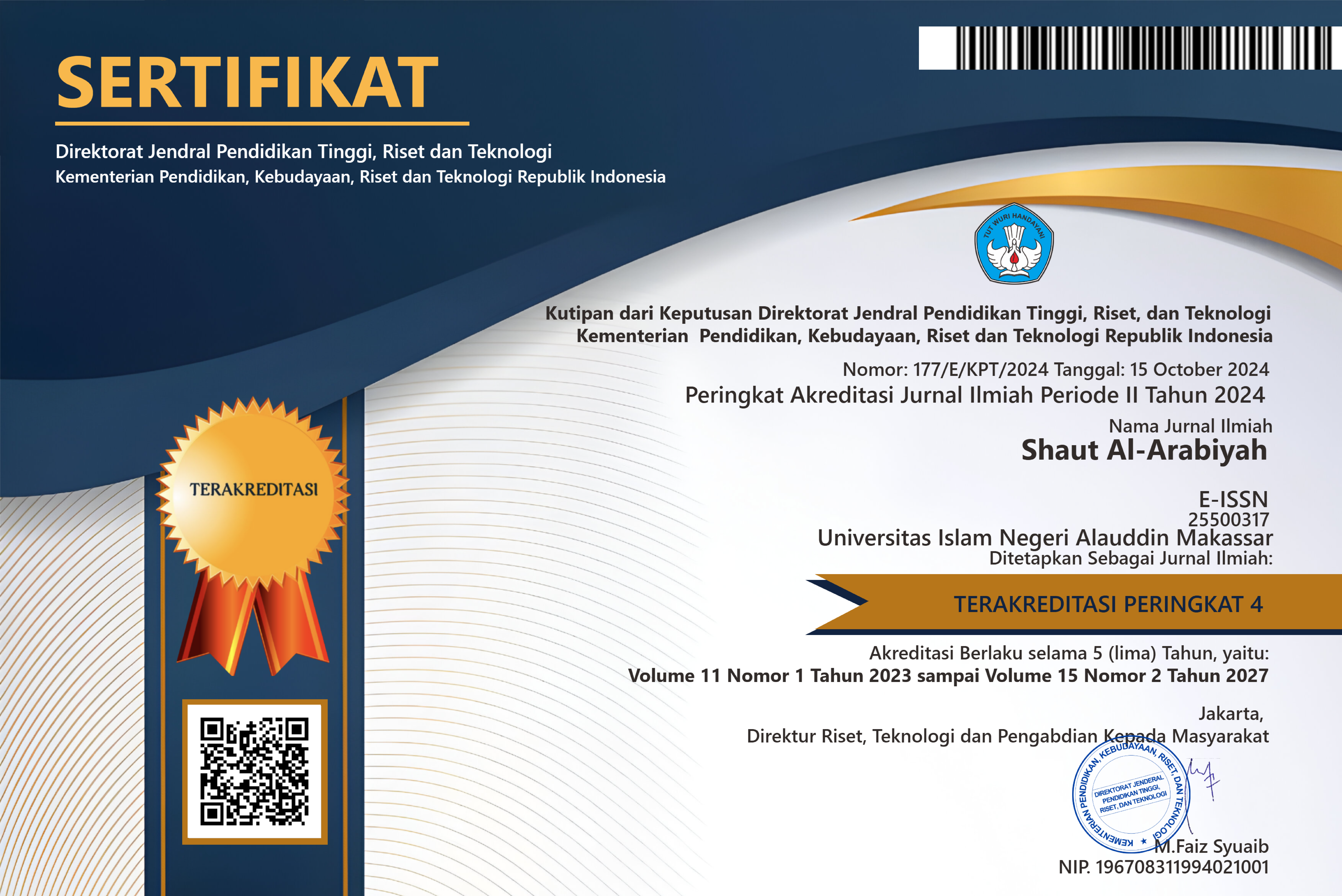Apakah Nahwu itu Shina’ah atau Ma’rifah?: Studi Epistemologi
DOI:
https://doi.org/10.24252/saa.v13i2.38775Keywords:
Nahwu; Ma’rifah; Shina’ahAbstract
The purpose of this research is to investigate the theoretical history and answer questions about nahwu between shina'ah and ma'rifah. In analysis, this paper utilizes a literature review method involving a qualitative approach. Literature synthesis is then used to present a deep understanding of the researched topic. The results show that nahwu, within the context of ma'rifah, is solely the Arabic language used for the Quran. Over time, it evolved into shina'ah. Similar in Bahm’s opinion, this process cannot be separated from six important components of science, namely: (1) issues, stemming from the presence of lahn, both among native and non-Arab speakers. (2) Attitude, established through the recommendation of Ali bin Abi Thalib to Abu al-Aswad ad-Duwaly for formulating nahwu. (3) Method used in constructing nahwu as shina'ah, which involves adding diacritical harakat and marks to the Quran. (4) Activities, developed through language codification in various phases, resulting in tashnif wa tajrid, schools of nahwu, and others. (5) Conclusion, after a long process, it can be concluded that nahwu has become a complex discipline but rich in benefits. (6) Effects, some of the positive influences resulting from the establishment of nahwu as shina'ah include better understanding of the Arabic language, effective communication, teaching and learning, research and scientific development, and preservation of Arab cultural heritage.
References
Al-Fadlali, Abdul Hadi. Marakizu Dirasati al-Nahwuyyah. Bairut: Maktabah Al-Manar, 1986.
Aman, Moh. “Bahasa Arab dan Bahasa Al-Qur’an.” Tadarus Tarbawy: Jurnal Kajian Islam dan Pendidikan 3, no. 1 (2021): 300-308. DOI: http://dx.doi.org/10.31000/jkip.v3i1.4256
Ardinal, Eva. “Pemikiran Syauqi Dhaif dan Upaya Pembaharuannya di Bidang Pengajaran Nahwu.” Jurnal Islamika 13, no. 2 (2013): 177-190. DOI: https://doi.org/10.32939/islamika.v13i2.5
Basuki, Sulistyo. Metode Penelitian. Jakarta: Wedatama Widya Sastra, 2006.
Dafrita, Ivan Eldes. “Ilmu dan Hakekat Ilmu Pengetahuan dalam Nilai Agama.” Jurnal IAIN Pontianak 9, no. 2 (2015): 159-179.
Hadi, Nurul. “Pembaharuan Nahwu Menuju Pembelajaran Bahasa Arab Praktis (Telaah Epistemologis Ilmu Nahwu Klasik).” OKARA: Jurnal Bahasa dan Sastra 6, no. 1 (2012): 39-52. DOI: https://doi.org/10.19105/ojbs.v6i1.421
Hamid, Muhammad Muhyidin Abdul. Ilmu Nahwu. Yogyakarta: Media, 2010.
Hayani, Fitra. “Leksikografi Arab (Sebuah Kajian Linguistik Terapan).” Jurnal Shaut Al-Arabiya 7, no. 1 (2019): 1-12. DOI: https://doi.org/10.24252/saa.v1i1.7786
Helmi, Muhammad, dan Sovia Rahmaniah. “Pandangan Filosofis dan Teologis tentang Hakikat Ilmu Pengetahuan sebagai Landasan Pendidikan Islam.” Tarbiyah Islamiyah: Jurnal Ilmiah Pendidikan Agama Islam 10, no. 2 (2020): 33-51.
Downloads
Published
How to Cite
Issue
Section
License
Copyright (c) 2025 Anisa, Asep Sopian

This work is licensed under a Creative Commons Attribution-NonCommercial-ShareAlike 4.0 International License.
















